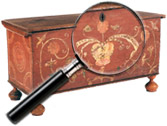|
|
Roseville Artwood Pattern
The Roseville Artwood Pattern originated in 1951. Each of the 13 shapes in this narrow line contains a cutout that goes through the entire piece. Within the cutout are decorative elements such as a geranium, Ming tree, tulip, palm tree, thistle, white flower or various branches with leaves. Artwood has an unmistakable 1950s “look,” but it was not a popular line and thus there is a lot of it in the [...] Click here to continue reading.
Harry Herman Roseland (1868-1950)
Born in Brooklyn, Harry Herman Roseland was one of America’s finest genre painters during the late 19th and early 20th century. He studied with Thomas Eakins, C. Beckwith; J.B. Whittaker (in Brooklyn) and was a member of the Brooklyn Art Club (1896); the Brooklyn Painters and Sculptor’s Association and the Brooklyn Society of Painters.
Roseland became famous for painting common laborers in fields, picking cotton or berries in and around [...] Click here to continue reading.
Rose Valley
The Rose Valley Association was a utopian crafts community located outside of Philadelphia, Pennsylvania. The colony was founded by William L. Price in 1901 and closed circa 1909.
Handcrafted furniture was one of the main products Price envisioned for Rose Valley, with designs featuring extensive hand carvings. A Gothic or Renaissance style was often used. Few case pieces were produced. Instead, Price preferred items with keyed tenons that allowed the furniture to [...] Click here to continue reading.
Louis Rorimer
Born in Cleveland, Ohio, on September 12, 1872, Louis Rorimer studied art in Europe from 1890 to 1895. He returned to the United States and was involved in the following companies in Cleveland:
Rohrheimer and Bowman Studio, 442 Old Arcade, 1896 to 1898. Rohrheimer and Hays, studios at 901-905 Garfield Building, workshops at 154-158 Champlain Street, 1898 to 1904. Rohrheimer Studios, 277-285 Old Erie Street near Euclid Avenue, 1904 to 1905. Rorheimer [...] Click here to continue reading.
Rookwood Pottery The Significance of Rookwood:
Rookwood Pottery of Cincinnati, Ohio, produced some of this country’s best and most highly collectible art pottery. The company, founded in 1880 by Maria Longworth Nichols (1849 to 1932), set the standard for high quality American art pottery. Rookwood also pioneered the use of underglaze slip decoration, employed some of the country’s best pottery decorators, and carefully controlled the production process to reduce errors. Throughout its 87 years [...] Click here to continue reading.
Henriette Ronner-Knip (Dutch 1821-1909)
The daughter and pupil of Neo-Classicist painter Josephus August Knip, Henriette Ronner-Knip gained notoriety early on as a landscape and still life painter. Her long and prolific career began with her first exhibition in Germany at the age of fifteen. By 1852, her work appeared regularly at the Paris salons and throughout England.
Knip moved from her native Amsterdam, Holland, to Brussels, Belgium, with her husband in 1859. There [...] Click here to continue reading.
Frederick Rondel (1826-1892)
Born in Paris in 1826, Frederick Rondel came to America where he became the only art teacher the great American artist Winslow Homer ever had. Rondel’s New England landscapes and paintings of New York City were ultimately influenced by the romanticism of his teachers in Paris, Theodore Gudin and Auguste Jugelet (Jugelet himself being a pupil of Gudin).
It is known that from 1855 to 1857 Rondel was in [...] Click here to continue reading.
Marie Jeanne Amelie Roman (1893-1955)
Born in St. James Parish, Amelie Roman was a descendant of Valcour Aime of Petit Versailles Plantation and of Louisiana Governor Andre Bienvenu Roman. After moving to New Orleans, she joined Ellsworth Woodward’s Saturday Drawing Classes. With the establishment of Newcomb College in fall of 1885, Amelie became a student in the first class of pottery decoration. Upon graduation, she was a member of faculty of Newcomb College of [...] Click here to continue reading.
John Rogers (1829-1904)
John Rogers was born in Salem, Massachusetts, but spent his early life in many places in New England and the Midwest, including Cincinnati. Rogers created plaster figural groups from 1859 to 1892 on the subjects of everyday life, the theatre, Shakespeare, the Civil War and horses. He created about 80 of these humorous genre images and purportedly over 80,000 casts were made. At a time when it was in vogue [...] Click here to continue reading.
Severin Roesen (circa 1815-1872)
Severin Roesen was born in Germany circa 1815 and came to New York City around 1847. Roesen was a devoted still life painter throughout his career. His prominence in American Art history was underscored by historian William H. Gerdts, who wrote “Roesen appears to have introduced a form of still life painting into American art which was…almost unknown here, at a propitious time for such an introduction…his still lifes [...] Click here to continue reading.
|
Recent Articles
- Charles Alfred Meurer – American Artist & Tromp L’Oeil Artist
- Sendak, Maurice – American Artist & Writer
- Godie, Lee – American Artist
- Davis, Vestie – American Artist
- Bartlett, Morton – American Artist
- Mackintosh, Dwight – American Artist
- Evans, Minnie Jones – African-American Artist
- Mumma, Ed (Mr. Eddy) – American Artist
- Nice, Don – American Artist
- Savitsky, John (Jack) – American Artist
- Gordon, Harold Theodore (Ted) – American Artist
- Dial, Thornton – African-American Artist
- Doyle Sam – American Artist
- Johnson, Lester Frederick – American Artist
- Finster, Howard – American Artist
|
|
